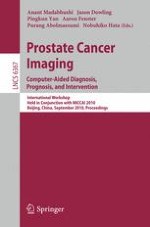2010 | OriginalPaper | Buchkapitel
Atlas Based Segmentation and Mapping of Organs at Risk from Planning CT for the Development of Voxel-Wise Predictive Models of Toxicity in Prostate Radiotherapy
verfasst von : Oscar Acosta, Jason Dowling, Guillaume Cazoulat, Antoine Simon, Olivier Salvado, Renaud de Crevoisier, Pascal Haigron
Erschienen in: Prostate Cancer Imaging. Computer-Aided Diagnosis, Prognosis, and Intervention
Verlag: Springer Berlin Heidelberg
Aktivieren Sie unsere intelligente Suche, um passende Fachinhalte oder Patente zu finden.
Wählen Sie Textabschnitte aus um mit Künstlicher Intelligenz passenden Patente zu finden. powered by
Markieren Sie Textabschnitte, um KI-gestützt weitere passende Inhalte zu finden. powered by
The prediction of toxicity is crucial to managing prostate cancer radiotherapy (RT). This prediction is classically organ wise and based on the dose volume histograms (DVH) computed during the planning step, and using for example the mathematical Lyman Normal Tissue Complication Probability (NTCP) model. However, these models lack spatial accuracy, do not take into account deformations and may be inappropiate to explain toxicity events related with the distribution of the delivered dose. Producing voxel wise statistical models of toxicity might help to explain the risks linked to the dose spatial distribution but is challenging due to the difficulties lying on the mapping of organs and dose in a common template. In this paper we investigate the use of atlas based methods to perform the non-rigid mapping and segmentation of the individuals’ organs at risk (OAR) from CT scans. To build a labeled atlas, 19 CT scans were selected from a population of patients treated for prostate cancer by radiotherapy. The prostate and the OAR (Rectum, Bladder, Bones) were then manually delineated by an expert and constituted the training data. After a number of affine and non rigid registration iterations, an average image (template) representing the whole population was obtained. The amount of consensus between labels was used to generate probabilistic maps for each organ. We validated the accuracy of the approach by segmenting the organs using the training data in a leave one out scheme. The agreement between the volumes after deformable registration and the manually segmented organs was on average above 60% for the organs at risk. The proposed methodology provides a way to map the organs from a whole population on a single template and sets the stage to perform further voxel wise analysis. With this method new and accurate predictive models of toxicity will be built.
